A comprehensive macaron troubleshooting guide with photos, possible causes and how to avoid the most common macaron issues!
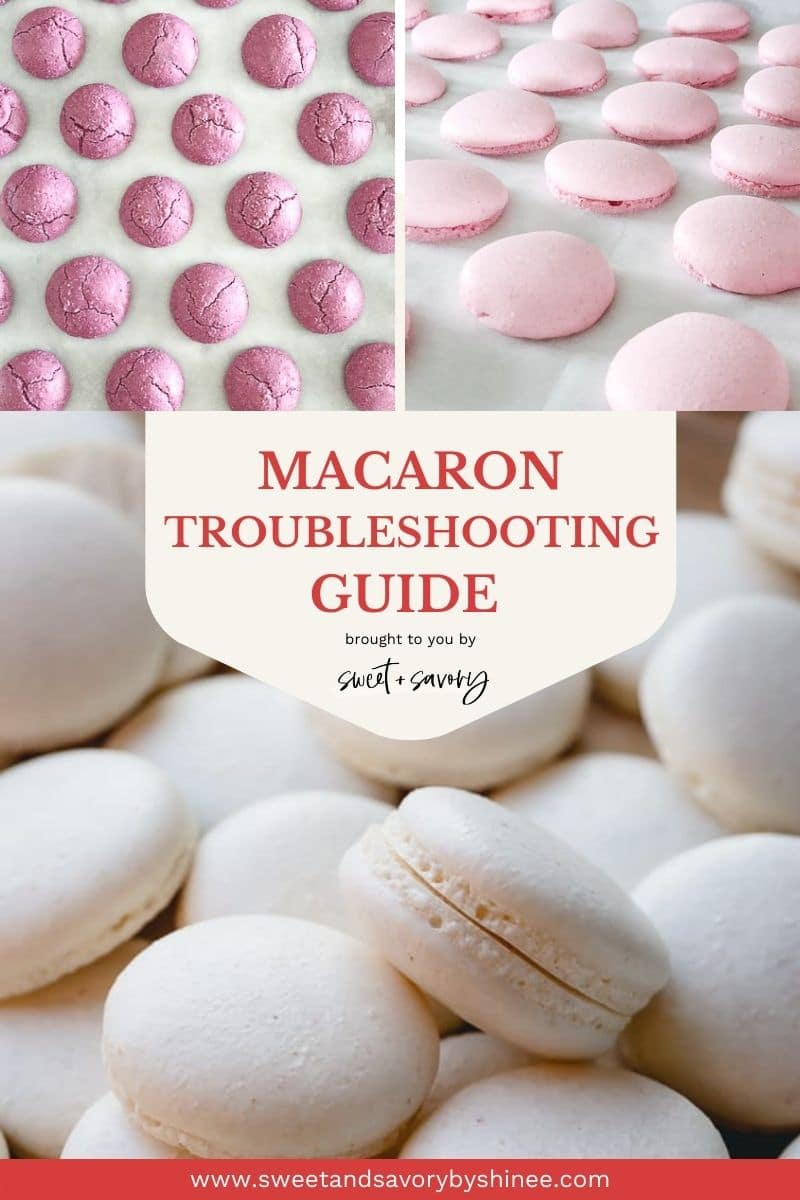
Table of Contents
Since 2012, I’ve made thousands of macarons in my home kitchen with many trials and errors, as well as picture-perfect macarons! And yes, I’ve had pretty much every problem imaginable!!
In the process, I’ve gained lots of tips and tricks to solve those frustrating issues and, most importantly, how to avoid them in the first place.
Remember, sometimes, macarons fail for no apparent reason and leave us scratching our heads.
But I encourage you to never give up on macarons. The joy of watching your macarons grow those ruffled feet and pulling out perfectly round macarons with shiny smooth tops is simply priceless.
I swear, every single time, when I see my macarons through the oven door puffing up and baking perfectly, I can’t help but do a little happy dance in my kitchen! Pure joy, I’m telling ya!
What’s a perfect macaron?
Perfect macaron is very subjective. To me, a perfect macaron has the following characteristics:
- Smooth shells
- Ruffles feet
- Full inside
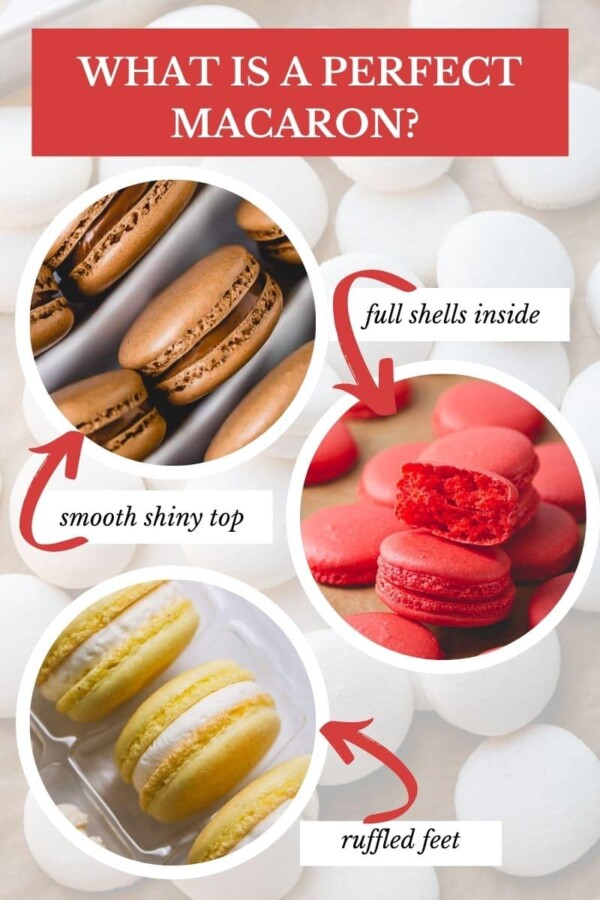
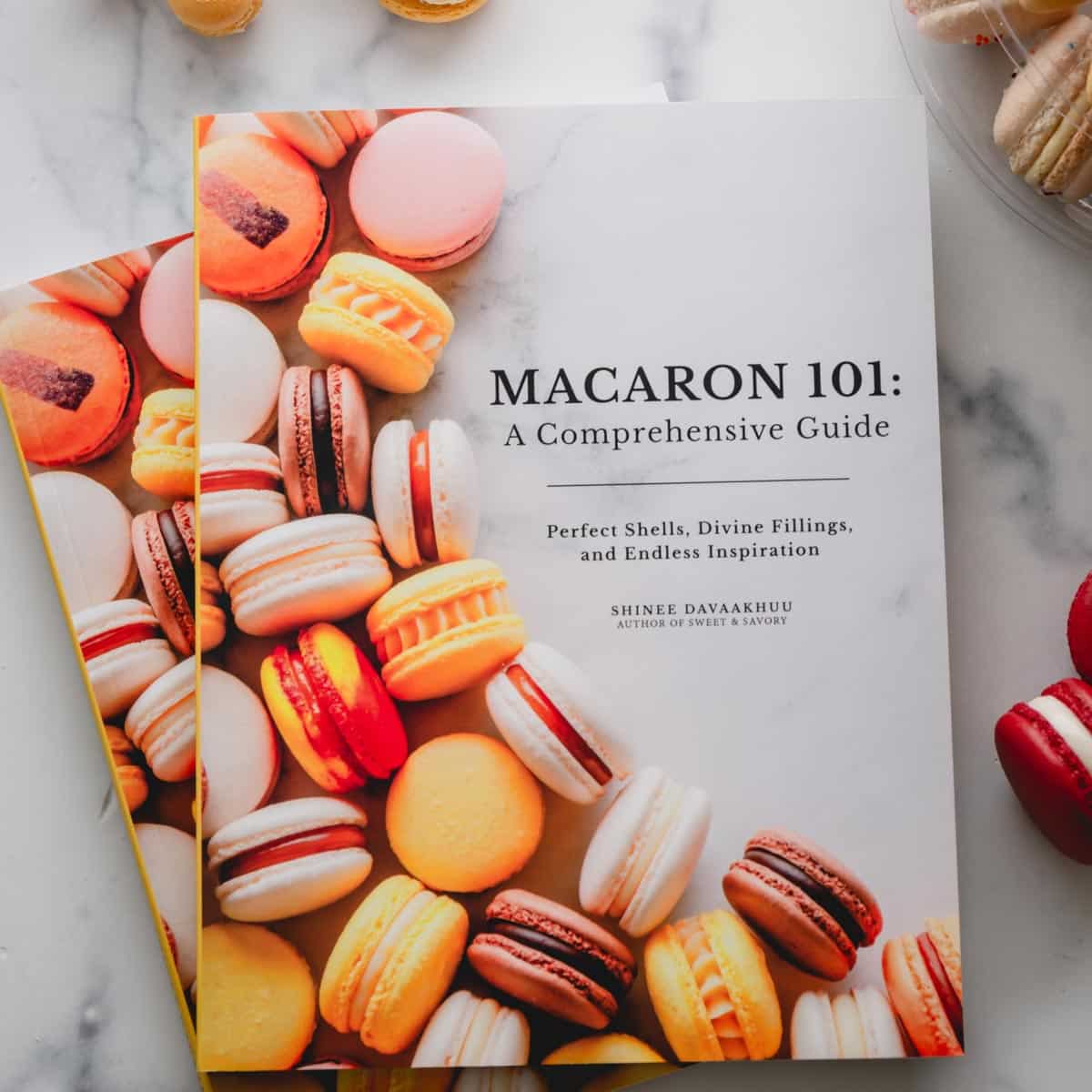
Macaron 101: A Comprehensive Guide
Master the art of French macarons and create your signature flavors!
Macaron Troubleshooting Video
Visual Macaron Troubleshooting Guide
Ok, let’s discuss each of the most common macaron issues, their causes and how to fix or prevent them!
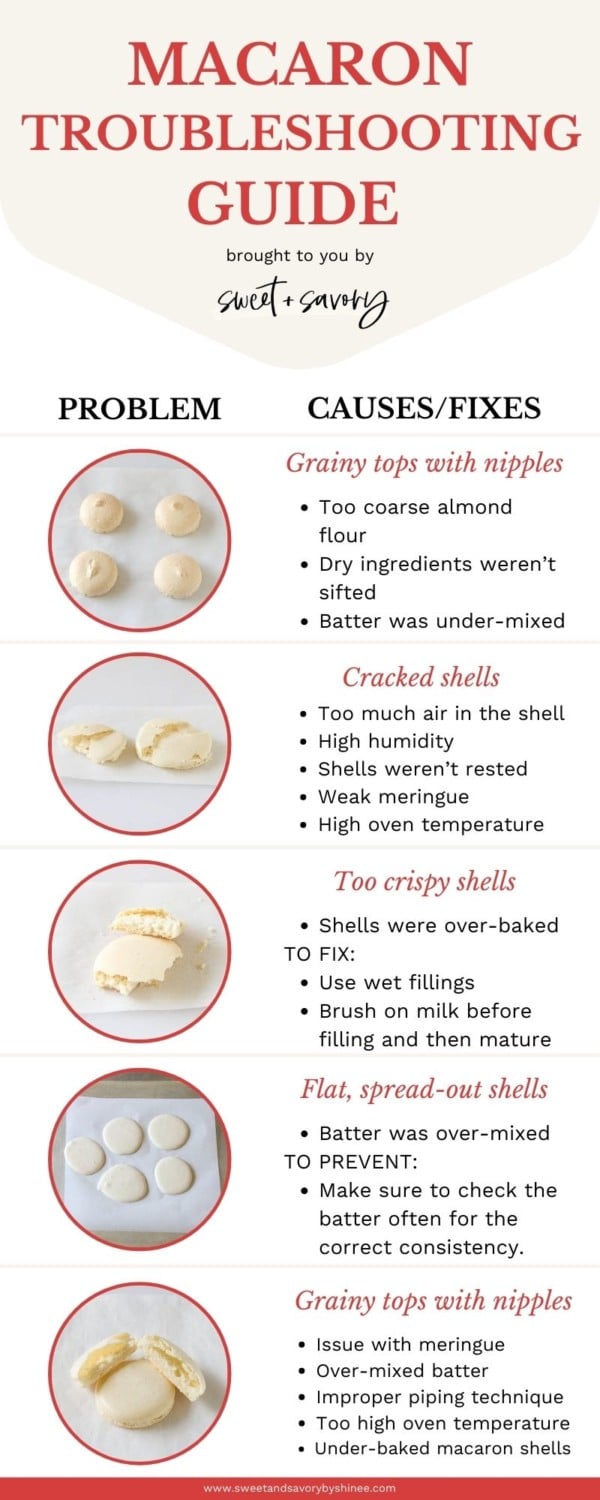
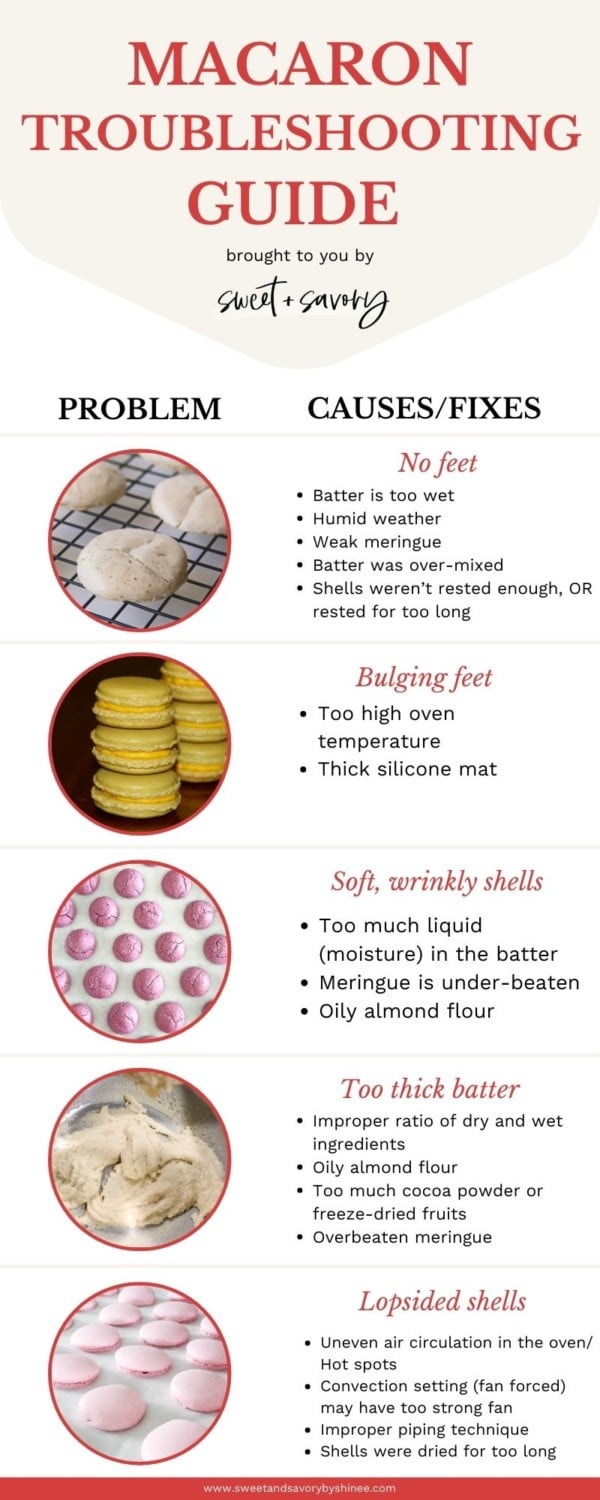
Pin this now to find it later
Pin ItUneven, grainy macarons with nipples
Possible causes:
- Too coarse almond flour
- Dry ingredients weren’t sifted
- Batter was under-mixed
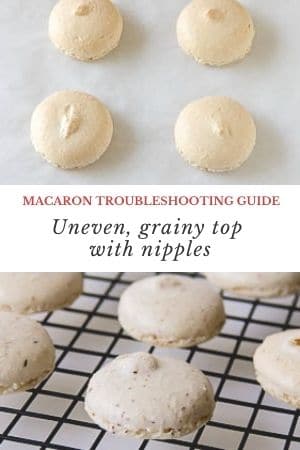
how to fix grainy shells with nipples:
- Make sure to use fine ground almond flour.
- Don’t skip sifting the dry ingredients! Toss large almond pieces left in the sifter. You shouldn’t have more than 1/2 tablespoon of almond bits.
- Under-mixed batter also causes grainy shells with nipples. When mixed right, the nipples should melt back into the batter after tapping the piped shells on the counter.
don’t do this!
Never use wet fingers to push the nipples down. Instead, use a toothpick to encourage the batter even out.
Cracked shells
Possible causes:
- Too much air in the shell
- High humidity
- Shells weren’t rested
- Weak meringue
- High oven temperature, or hot spots in the oven
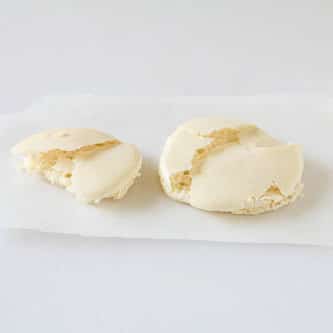
HOW TO FIX cracked macarons:
- Be sure to tap the baking sheet right after piping macaron shells. And use a toothpick to pop large air pockets visible on the surface.
- When it’s too humid, the shells don’t develop good skin, which leads to the next point.
- When the shells haven’t rested long enough to develop skin on top, steam releases from anywhere cause macarons to crack on top.
- Take your time to make nice and sturdy meringue, especially when you’re making French meringue. Watch my video on French Meringue 101 to learn all the tips to make the most stable French meringue.
- Too hot oven can also cause cracks in macaron shells. Make sure to get an oven thermometer to double check the temperature inside the oven without relying on what oven says.
Erupted shells
Possible cause:
- Touched the shells with wet finger to push down a pointy nipple
How to prevent erupted volcano macarons:
Never touch your unbaked macaron shells with wet fingers to push down pointy end. Instead tap the baking sheet well. And if the pointy end doesn’t melt into the batter, you can either baking them as is, or scrape the batter back into a bowl and mix for a little more until the batter is at correct consistency.
Too crispy interior
Possible cause:
- Shells were over-baked
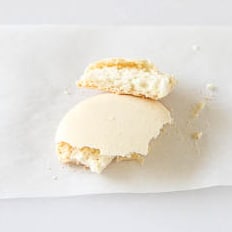
How to fix too crispy shells:
If you over-baked your macaron shells and now they’re super crispy throughout, don’t fret! 2 easy fixes:
- Use wet fillings, like jams, caramel sauce, or lemon curd in the center.
- Simply brush on milk on the bottom of the shells before piping a filling of choice.
don’t miss this important step
Mature the filled macarons for 24 hours. The shells will absorb the moisture from filling and macarons should soften nicely.
Flat shells, spread out too much
Possible cause:
- Batter was over-mixed
Over-mixed batter is too loose and the shells don’t hold its shape well, instead it spreads out too much.

How to prevent flat, spread out macarons:
Once macaron batter is over-mixed and it’s too runny, there’s no way to salvage it. So it’s important to prevent this from happening.
Make sure to check the batter often for the correct consistency. It should slowly run off the spatula into a ribbon, and the edges should melt back into the batter within about 10 seconds.
Hollow shells
Possible cause:
- Issue with meringue
- Over-mixed batter
- Improper piping technique
- Too high oven temperature
- Under-baked macaron shells
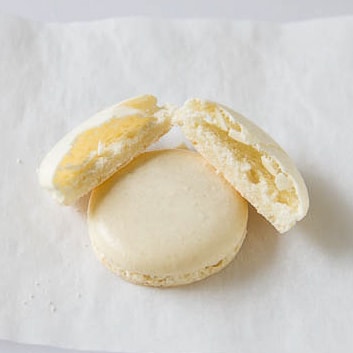
How to fix hollow macaron shells:
Hollow macarons are so common, and I personally battled with this issue for a long time. Now, I consistently get full, meaty macarons straight from the oven.
Since it’s a complex issue, I dedicated a separate post on how to fix hollow macarons.
No feet
Potential causes:
- Batter is too wet
- Humid weather
- Weak meringue
- Batter was over-mixed
- Shells weren’t rested before baking
- Shells were rested for too long, weakening the meringue structure
- Too low oven temperature
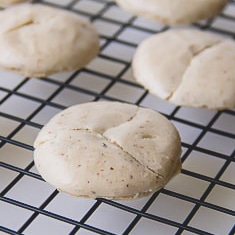
How to prevent no feet macarons:
- When the batter is too wet, macarons don’t develop those ruffled feet. The most common causes for wet batter: excess liquids, like extracts, lemon/lime juice, liquid food coloring, too much gel food coloring, etc.
- In some cases, especially in humid climates, aging egg whites might be beneficial. During aging, egg whites loose some of its moisture.
- When the meringue isn’t whipped to stiff peaks, it doesn’t have strong enough structure to lift macarons. Watch my French Meringue 101 video for visual cues for proper meringue.
- When macaron batter is over-mixed, there’s not much air bubbles left to give the shells lift during baking. Therefore, they come out flat without feet.
- Also, if macarons weren’t rested to form a skin before baking, it could cause no feet macarons. And if the shells were rested for too long, it can also negatively affect the batter, because meringue loses its stability when sat for too long. Keep checking the shells every 15 minutes and put them in the oven as soon as they don’t stick to your fingers.
- If the oven is not hot enough, macarons won’t rise as air bubbles in the meringue need heat to expand to lift the shells, creating that pretty feet at the base.
check the accuracy of your oven
Make sure to get an oven thermometer to double check the temperature inside the oven without relying on what oven says.
Bulging feet
Potential causes:
- Too high oven temperature
- Silicone mat
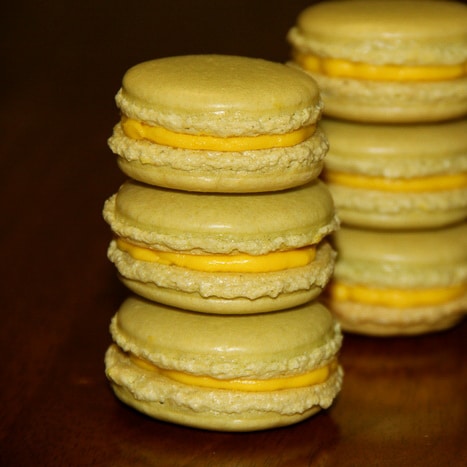
how to prevent bulging feet:
Some may find it ugly when the ruffled feet extends out of the macaron shells. I’m not a huge fan, but it’s not the worst!
- This happens when the oven is a bit too hot, causing the macarons to rise too high and then collapse slightly, making the feet bulge out.
- And another reason is silicone mat might be the culprit. I certainly happens to me with thick silicone mats, but I know some people have gorgeous macarons with silicone mats.
Soft, wrinkly shells
Possible causes:
- Too much liquid (moisture) in the batter
- Meringue is under-beaten
- Oily almond flour
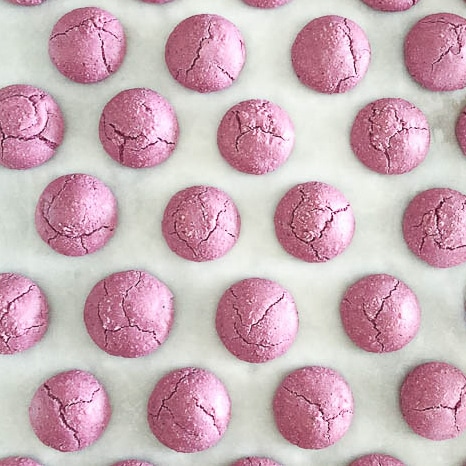
How to prevent soft, wrinkly shells:
Excess moisture and/or fat is the #1 cause for soft, wrinkly shells. And there’re number of culprits for excess moisture/fat in the batter:
- Adding liquid extracts, juices or liquid food coloring
- Adding cocoa powder, freeze-dried fruits, etc.
- Under-mixed meringue also contains too much moisture
- Oily almond flour, or almond flour that has been opened for too long
Cocoa powder contains fat which could potentially cause soft, brownie-like macaron shells. And freeze-dried fruits absorb moisture from the air fast and could cause soft, wrinkly shells as well.
how to store almond flour
Store opened almond flour in an airtight container in a cool place. You can also store in the freezer for long-term storage.
Too Thick batter
Typically, when you add dry ingredients into meringue, it starts out pretty thick and that’s totally normal. As you fold the batter, it thins out and gets runnier.
In rare occasions, the batter never loosens and it stays thick.
Possible causes:
- Improper ratio of dry and wet ingredients
- Oily almond flour
- Too much cocoa powder or freeze-dried fruits
- Overbeaten meringue
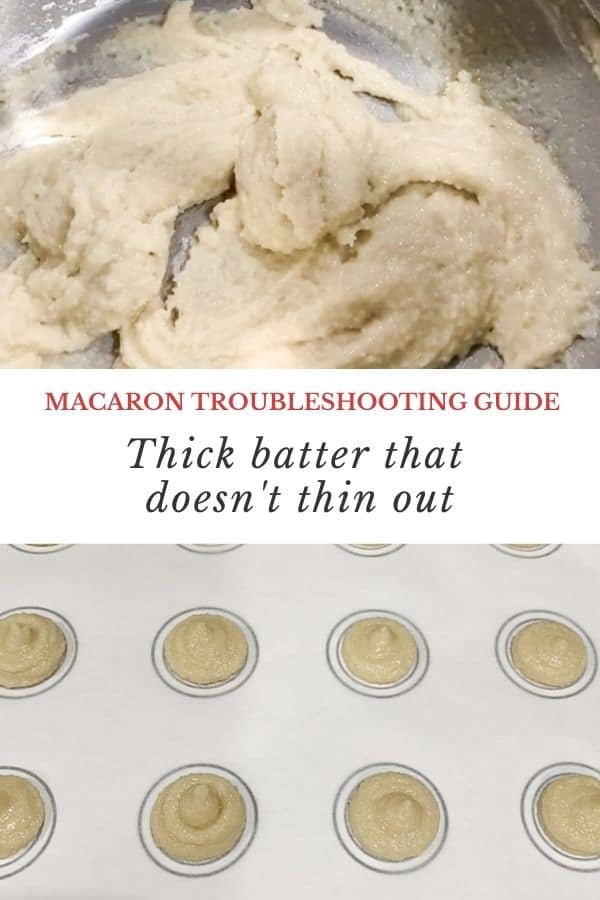
how to fix and prevent thick batter issue:
- Be sure to weigh the ingredients carefully. I strongly recommend weighing all the ingredients, including egg whites, with a kitchen scale.
- Oily almond flour could cause thick batter. Make sure to use fresh almond flour and avoid processing it in a food processor.
- Too much cocoa powder or freeze-dried fruits can throw the ratio of dry and wet ingredients.
- When meringue is over-beaten, it gets dry, throwing off the ratio as well.
Blotchy shells
I don’t have a photo of this issue, but basically it looks like greasy stains on the shells.
Possible causes:
- Oily almond flour
- Batter sat out for too long before piping
how to prevent blotchy macarons:
- Use fresh almond flour that’s not oily. To test, squeeze some almond flour in your hand and see if it holds its shape. If it holds its shape like wet sand, then it’s too oily.
- Make sure to pipe the shells right away, especially with French meringue batter.
Lopsided shells
Possible causes:
- Uneven air circulation in the oven/ Hot spots
- Convection setting (fan forced) may have too strong fan
- Improper piping technique
- Shells were dried for too long
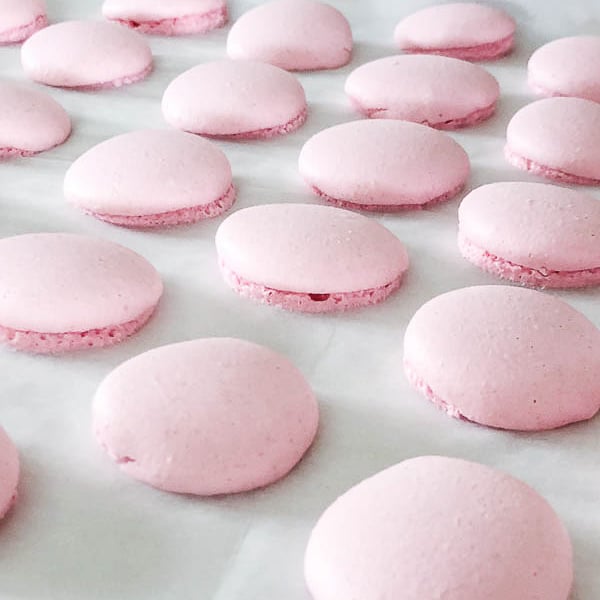
how to prevent lopsided macarons:
Main culprit for lopsided shells is poor air circulation. This could be due to uneven heat distribution and hot spots in the oven, convection settings with too strong fan. Here’re a few things you can do in this case:
- Flip the baking sheet upside down before piping macarons, so that there’s no edges around the sheet to block any heat circulation.
- Bake macarons one sheet at a time.
- Turn the baking sheet around half way through baking.
- If possible, bake on conventional setting, heat coming from top and bottom.
The next reason for lopsided macarons is improper piping technique. Pay close attention to following:
- Hold the piping bag with macaron batter straight at 90° and squeeze the batter from the top to one spot until the desired size reaches. Watch my macaron video for better illustration.
- Pipe the shells at least half an inch apart to give the shells enough room for air circulation.
And lastly, don’t dry your macarons for too long. Too thick skin may cause lopsided macarons.
Concaved (Inverted) shells or Stuck To Parchment
Possible causes:
- Low oven temp/ low heat from bottom
- Under-baked shells
- Not cooling the macarons before removing from parchment paper
How to prevent concaved, or stuck macarons:
- Make sure your oven is hot enough. Most of the time, ovens need good 30-45 minutes to preheat properly. Even if it beeps when it’s preheated, I highly recommend double checking with an oven thermometer.
- Be sure to check the macarons for doneness before taking them out. To test for doneness, gently touch the top of one macaron with your index finger and try wiggle it. If it wobbles side to side, they’re not ready. keep baking for another minute or so. The cooked shells should wiggle ever so slightly and firm to touch. When in doubt, cook a bit longer. In my opinion, it’s better to over-bake them than under-bake them.
- Make sure to cool the macarons on the baking sheet for at least 10 minutes before removing from parchment paper/silicone mat.

Macaron 101: A Comprehensive Guide
Master the art of French macarons and create your signature flavors!

Whew, are you still with me? Thank you!!! I hope this macaron troubleshooting guide answers your questions and helps you to perfect your macaron skills.
And if there is anything I haven’t covered, please leave me a comment below. I’d like us, macaron-lovers, connect and discuss various problems we face baking macarons. Let’s get the discussion started.


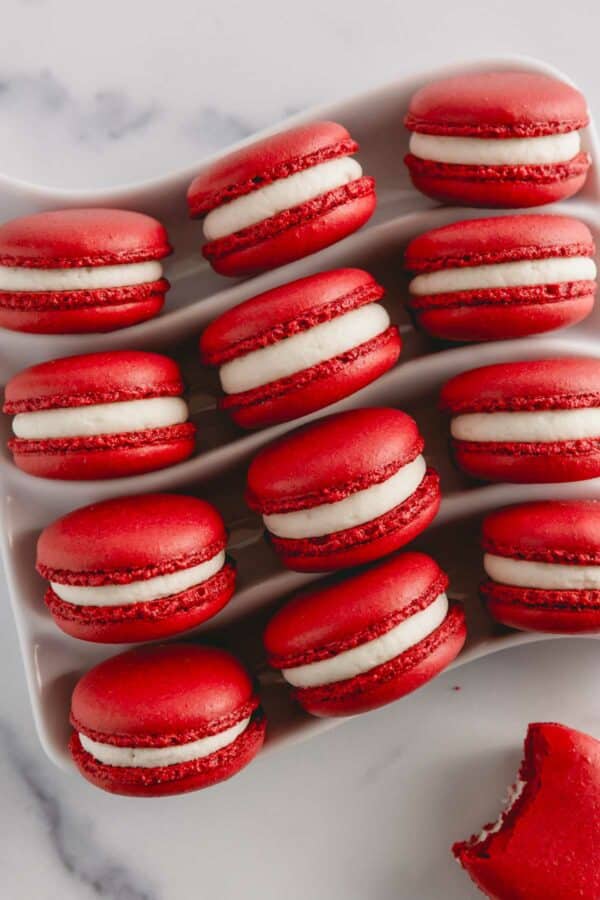
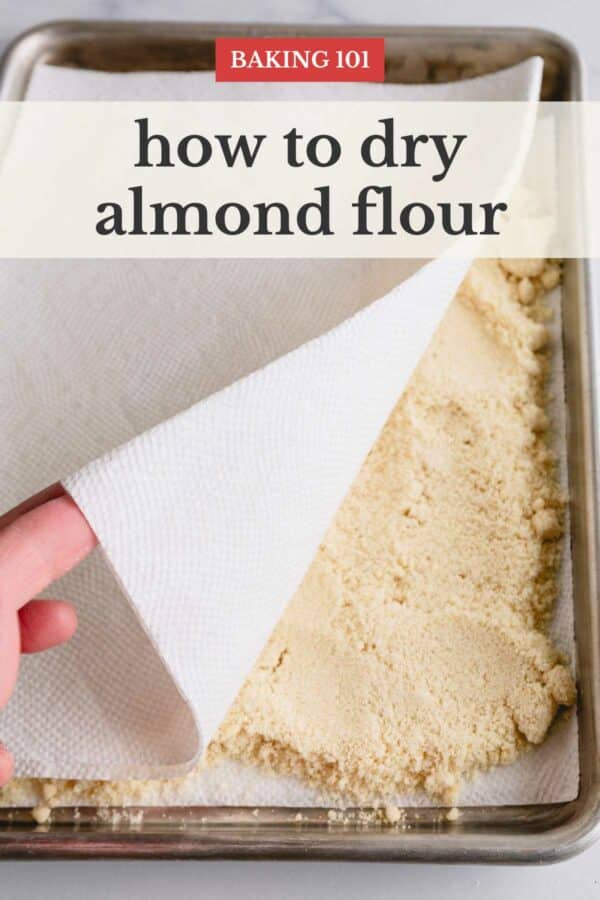
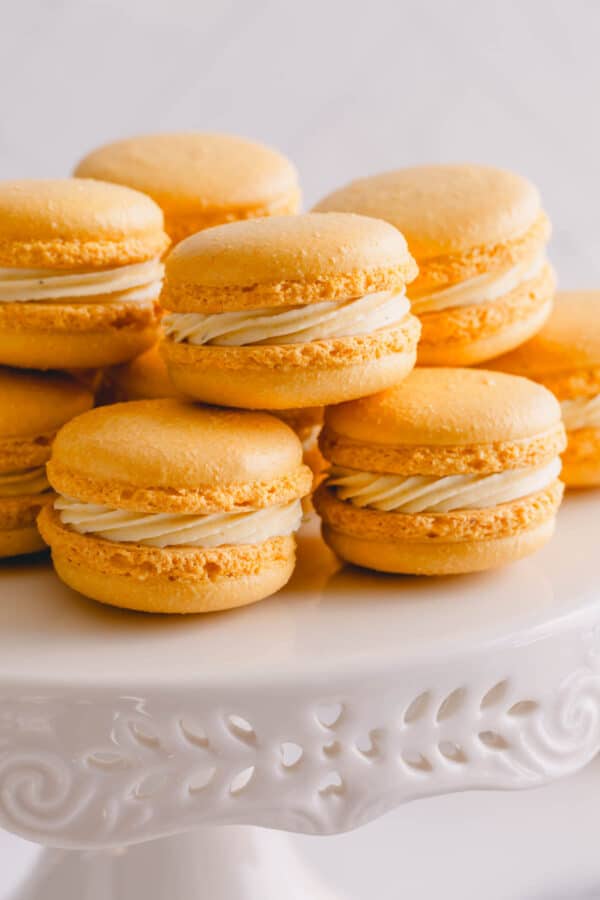

Hi, mine turned out great except that the second time I made them they didn’t have a shine. I have no idea what I did differently the first time. What factors contribute to shine? My best guess is that I undermixed the second batch but I was curious what other things affect shine as well.
Hi, Maddie. So most of the time, rest time affects the shininess. The longer you rest, the duller the macarons are. I’ve heard some speculation regarding food coloring affect that too. Did you add any food coloring to your first or second batch?
I recently had my most successful batch of macarons, entirely due to awesome videos that showed correct meringue and macronage techniques – thanks so much Shinee! I have tried something a bit different though – I read that the skin technique might actually be a bit of a myth, and I inadvertently tested this yesterday by making smaller ones which lead to 2 pans sitting out for about 45 minutes. Those two pans ended up with almost half cracked tops, which still had the right texture but didn’t look as nice. I admit, they were also different pans and used parchment instead of silicon mats, so that might have been a factor, but the ones on the pan that went straight in baked perfectly fine. I did have a ceiling fan and the a/c going, so maybe the humidity was low enough that the skin didn’t matter? Something to think about anyway!
Hi, Caroline. Thank you for your feedback. So happy to hear your macaron success. And I agree with you, no rest macarons do work for some people, and I suspect it has a lot to do with the climate. In dry climate, it’s probably a lot more forgiving. Now that’s just my suspicion, so don’t quote me on that. In the past 7 years, I sure tried no-rest, but I must have never documented it. But one of the main issues with baking macarons without the skin formed is cracked shells and no ruffled feet.
Hi Shinee, I’ve been attempting macarons for the past week or so, and I made 3 batches. All of them cracked and have no feet but they taste exactly how macarons should taste, crispy outside and chewy inside. I think my batter is too runny (overmixed batter, I’m assuming) and now I’m too scared to make another batch cause I’m scared it will fail again haha but I have a few questions to ask :
– how long does it typically need to rest? I left mine out for 3-4 hours (I live in a rather humid country) and I’m able to touch them but they’re still considered rly wet and sink in when poked. Should I leave it out longer and try to save it or it’s alrd considered a fail?
– when baking, the macarons rise in the middle and crack after awhile, plus they don’t develop feet. I use a silicon macaron base while baking. Is this caused by the temperature of the oven being too high?
– Based on videos and tutorials that I watched, When piping macarons, most of their macarons stay in shape and have grainy texture while mine looks smooth but runny. Is this due to over mixing as well? I do stop mixing once I achieve the “figure 8” as most tutorials say. Should I also add almond powder to the batter when mixing if its too runny?
Hi, Sara. Thank you for reaching out! So, it does sound like your batter is over-mixed.
1. The resting time really depends on humidity. I live in a relatively dry climate, and it takes me about 20-30 minutes to dry. In humid climate, it can take hours. When you touch the macarons, the batter should not stick to your fingers. Since you live in a humid climate, I suggest to use a fan in the kitchen to promote drying quicker.
2. Make sure to tap the baking sheet with macaron shells after piping to burst all the bubbles. If not, the trapped air bubbles will burst during baking.
3. I’d recommend to try baking your macarons on parchment paper, instead of silicone mat. I don’t like most silicone mats, because they don’t transfer heat evenly.
4. Make sure to pipe the shells immediately after you mix the macaron batter. If you let the batter sit for bit, especially in warm environment, the batter will become runny. And stop mixing slightly before you think it’s done.
5. No, don’t add more almond flour if you over-mix the batter. It won’t fix the issue. When in doubt, under-mix the batter.
Hope this helps. Please let me know if you try baking macarons again.
Shinee, Sorry to bombard you with questions… what are your thoughts/experiences with garnishing the shells with a dusting of cocoa powder, spices or sprinkling sugar? Will it affect them cooking properly? I assume you do this right after piping and before they rest.
I followed your recipe and invested in an oven thermometer and a kitchen scale! My macarons came out really well and adorable! they weren’t brown, flat, and cracked all at the same time anymore! thank you so much! ive followed other recipes but they were always a flop. I appreciate you and this recipe so much!
Oh that’s awesome, Pea!! I’m so happy my guide was helpful! Thank you for your feedback!
Hi, right now I’m making macarons and they’re in the oven but.. the feet seems a lot thicker than my other attempts (which have come out perfectly) and also the tops are soft and not hard which is odd. I know for a fact I didnt overmix my batter so I’m not sure what the problem is. I cracked one open and they’re not hollow. If anything, they’re just soft on top. Shoudl I put them back in the oven at a higher temp?
Hi, Ellen. It’s hard to say exactly what may be causing the issue. It could be due to almond flour, too much moisture/ humidity. Which recipe did you make?
Hi Shinee, I was thinking of trying some of the LorAnn products to vary my macaron shell flavors and am wondering if you can recommend which of their products would be best for using for macaron shells? Thank you!
Hi, Cynda. I’ve used their pumpkin spice bakery emulsion and chocolate hazelnut flavor. They both worked great.
Thank you. I will stick with looking at the bakery emulstions… I had a feeling the oils might affect the meringue.
Yes, oils are risky and will break down your meringue.
Hello!
My macarons came out brown, flat, and cracked at the same time. they did have tiny feet, but other than that, it was a disaster, any reasons or tips? thank you!
Hi, Pea. What recipe did you use? I recommend to review this troubleshooting guide for more details. But from your description, it sounds like your batter was overmixed, which makes the batter too runny and the shells spread flat, which causes the flat shells. And I’d try to reduce your oven temperature by 15-20°F, brown cracked shells may indicate that they were baked at too high temperature. I also suggest getting an oven thermometer to make sure your oven temp is accurate.
Every time (being 4 times) they are absolutely perfect BUT they have wrinkled skins……….? What is happening?
Hi, Penny. Wrinkled skin usually indicates excess moisture. Is it humid where you live? If the climate is nice and dry, then I’d check your almond flour. It shouldn’t be too oily. And another thing is are you adding any liquids to the meringue, like flavorings or liquid food coloring?
Hello! The only issue I ever get is when I try dusting them with something like espresso powder for example. It completely ruins my shells. I know other bakers do it just fine so not sure why it doesn’t work for me
Hello, first attempter here! I must’ve used the hand mixer for 12 minutes and could not get hard peaks… I got probably soft and medium. Is there anything I am missing you mix with the egg white besides cream of tartar and sugar? Was I supposed to use powdered sugar? Additionally, I tried the batter check method and felt it was good. I still had wrinkly soft macarons after baking. Could there be any other reason? Thanks in advance!
Hi, La. If you meringue didn’t whip into stiff peaks, I suspect you may had a drop of egg yolk in the whites, or bowl/whisk had streaks of fat/oil. It sounds like your meringue didn’t whip to hard peaks, causing the wrinkly soft macarons. No powder sugar in meringue. Just a little salt and cream of tartar, and granulated sugar.
Thank you! Will try again.